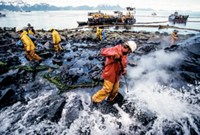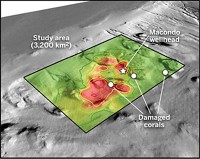Advertisement
Grab your lab coat. Let's get started
Welcome!
Welcome!
Create an account below to get 6 C&EN articles per month, receive newsletters and more - all free.
It seems this is your first time logging in online. Please enter the following information to continue.
As an ACS member you automatically get access to this site. All we need is few more details to create your reading experience.
Not you? Sign in with a different account.
Not you? Sign in with a different account.
ERROR 1
ERROR 1
ERROR 2
ERROR 2
ERROR 2
ERROR 2
ERROR 2
Password and Confirm password must match.
If you have an ACS member number, please enter it here so we can link this account to your membership. (optional)
ERROR 2
ACS values your privacy. By submitting your information, you are gaining access to C&EN and subscribing to our weekly newsletter. We use the information you provide to make your reading experience better, and we will never sell your data to third party members.
Environment
Cleaning Up The Gulf Oil Spill
Response teams use multiple techniques, including a new one, to try to protect coastal wetlands
by Michael Torrice
May 17, 2010
| A version of this story appeared in
Volume 88, Issue 20

As black tarlike and reddish brown oil floats on the Gulf of Mexico, response crews continue their vast clean-up effort. Scientists and engineers hope that the crews’ multipronged attack of standard oil clean-up techniques—and one that had never been tried before—will minimize the amount of oil seeping into the Gulf’s fragile wetlands.
“We’re trying to use all the tools in the toolbox,” says geochemist Jacqueline Michel, president of Research Planning, in Columbia, S.C., a contractor for the National Oceanic & Atmospheric Administration (NOAA) that does scientific assessment during oil spills. “No one thing is totally successful. We need a Swiss Army knife.”
The spill began after an April 20 explosion on the Deepwater Horizon oil exploration rig ruptured the pipe that led from the wellhead up to the platform. Soon after, 5,000 barrels of oil per day started spewing into the ocean from three leaks in the pipe.
In an attempt to stop the ongoing spill, BP engineers on May 7 lowered a four-story containment dome onto the leaking pipe but quickly met with complications.
Meanwhile, to deal with oil already on the ocean’s surface, the spill’s response teams of BP engineers, government scientists, and private consultants have employed three basic tools, all of which have been used in oil spills for the past few decades.
Boats have placed polyethylene moplike pads called skimmers on the ocean’s surface to absorb oil. As of May 10, these crews had recovered 3.6 million gal of an oil-water mix.
Crews have also corralled oil slicks with fire-resistant booms for what are called “in situ burns” on the ocean. Two May 5 blazes burned more than 1,000 bbl of oil.
“When it works, burning is one of the more effective means available for dealing with a spill,” says chemist Jeffrey Short, who spent most of his career with NOAA studying the 1989 Exxon Valdez spill, and who is now the Pacific science director of Oceana, an environmental organization in Juneau, Alaska. “You can burn up to 90% of the oil that you’ve managed to capture,” he says.
But for burning to succeed, the sea must be calm and the oil must not have mixed much with the water. Storms in the Gulf have limited the usefulness of in situ burns for the spill.
The technique also isn’t perfect, Short says. Although burning removes oil’s more toxic components—its aromatic and aliphatic compounds—the technique leaves behind stickier asphaltenes, the high-molecular-weight compounds that refineries distill from crude oil to make road tars (C&EN, Sept. 21, 2009, page 12).
Using the third traditional method, planes have sprayed dispersants, a mixture of surfactants and solvents, onto the slicks. The hydrophobic portions of the surfactants encircle the oil, and their hydrophilic ends contact the water to form micelles. Like dish soap, dispersants break the oil into smaller droplets that fall from the surface into the water column, where microbes degrade them or ocean currents push them farther out to sea.
To break up the oil and disperse it before it reaches the surface, BP engineers have also experimented with a new approach: applying dispersants under water (C&EN, May 10, page 8).
In three tests since April 25, boats have pumped dispersants down to remotely operated underwater vehicles near the leaks. Those vehicles aimed the dispersants at the leaking oil plume. Using the vehicles’ video cameras, engineers watched as the mixture scattered the oil into the water column.
As of May 11, federal officials were reviewing the results of the tests. BP spokesman John Curry called them “encouraging.”
Geochemist Edward Overton of Louisiana State University (LSU), Baton Rouge, approves of attempting to prevent the oil from rising to the surface. This crude oil’s high levels of asphaltenes, he says, and its 5,000-foot journey to the surface both favor formation of emulsions, which are mixtures of water and oil that are extremely difficult to clean up. From the air, these emulsions look like reddish brown streaks in the ocean.
In tanker spills, oil starts on the surface, and the waves and winds then mix it into the water. “But here, as it hits the surface, we may already have an emulsion,” Overton says.
In an emulsion, the oil has less exposed surface area than it would in a slick, so sprayed dispersants are less effective and microbes have less access to the oil, Overton says. Avoiding emulsification would be a strength of the underwater strategy, he adds.
But dispersants aren’t without their drawbacks, experts say. Some environmental groups, such as the Natural Resources Defense Council, have raised concerns about dispersants’ possible toxic effects on coral reefs and other marine life.
Earlier formulations had toxicity issues, Overton acknowledges. But newer dispersants such as the Corexit 9500 compound produced by Nalco—one product used in the Gulf clean-up effort—have lower toxicities. Today’s dispersants are about 10 times less toxic than the dispersed oil itself, according to a 2005 National Research Council report on the chemicals’ efficacy and effectiveness. Corexit 9500’s Material Safety Data Sheet characterizes its hazard to the environment as low.
However, the dispersants still pose an environmental concern, Research Planning’s Michel says. They expose marine life in the water column to more oil than would be the case for untreated oil, which floats at the surface.
Still, Michel and other experts argue that the trade-off seems worthwhile. Oil in the water column, she notes, won’t reach wetlands on shore, where it could wreak greater havoc.
The wetlands are extremely important habitats that need protection, says marine chemist Christopher M. Reddy of Woods Hole Oceanographic Institution, because they serve as the focal point for the Gulf’s food chain. They also prevent erosion of the coast. “The marsh grass acts like rebar,” Reddy says, “and the peat acts like cement to give a fortified barrier.”
The fragile nature of the wetlands will complicate clean-up efforts when the oil comes ashore, says Nancy E. Kinner, codirector of the University of New Hampshire’s Coastal Response Research Center. Simply visiting the sites to clean them up can cause harm. “If you walk on a wetland, that impact can stay for a long time because you damage the plants’ root systems, which are the base of that whole food chain,” she says.
As a result, wetland clean-up crews often rely on a less invasive method, allowing indigenous microbes to digest the oil’s toxic compounds, says environmental scientist Ralph Portier, a colleague of Overton’s at LSU. In a 2006 spill in which oil leaked from tanks at a Louisiana refinery into nearby wetlands, this bioremediation method successfully lowered amounts of oil below hazardous levels within months, Portier says.
To coax microbes into growing faster, crews will often spray wetlands with dilute solutions of nitrate- and phosphate-based fertilizers. According to Portier, “It’s like watering your mom’s rose bushes.”
Portier and coworkers have run preliminary tests on the Gulf’s indigenous microbes’ ability to degrade this spill’s crude. In the experiments, the scientists filled crude-oil-coated flasks with ocean water teeming with the microbes and rocked the flasks to simulate wetland tides. The results have made Portier hopeful about the clean-up effort: Within three days, the oil had degraded so much that it collapsed off the flask walls. And, from feeding off the oil, the microbes had multiplied to a density of 106 cells per liter.
“If we can get those densities in the wetlands,” Portier says, “we’re going to get really dramatic reductions in oil.”





Join the conversation
Contact the reporter
Submit a Letter to the Editor for publication
Engage with us on Twitter